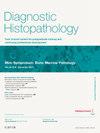非小细胞肺癌预后的组织学预测因素
引用次数: 0
摘要
组织病理学诊断和报告非小细胞癌已被帮助的因素,影响预后的理解。本文将探讨影响非小细胞肺癌患者预后的几个因素。这些包括:非小细胞癌的分级、淋巴血管浸润、通过空气间隙扩散和胸膜浸润。我们讨论了如何识别和量化这些因素,以及它们对预后影响的已知证据。总之,更好地了解这些因素并将其纳入组织病理学报告将有助于治疗计划和患者预后。本文章由计算机程序翻译,如有差异,请以英文原文为准。
Histological predictors of outcome in non-small cell lung cancer
The histopathological diagnosis and reporting of non-small cell carcinoma has been aided by an understanding of the factors which affect prognosis. In this review we will consider a few factors which can affect prognosis of patients with non-small cell lung carcinoma. These are: grading of non-small cell carcinomas, lymphovascular invasion, spread through air spaces, and pleural invasion. We discuss how to identify and quantify these factors, and the known evidence for their effect on prognosis. In conclusion, a better understanding of these factors and their inclusion in histopathology reports will help treatment planning and patient prognostication.
求助全文
通过发布文献求助,成功后即可免费获取论文全文。
去求助
来源期刊

Diagnostic Histopathology
Medicine-Pathology and Forensic Medicine
CiteScore
1.30
自引率
0.00%
发文量
64
期刊介绍:
This monthly review journal aims to provide the practising diagnostic pathologist and trainee pathologist with up-to-date reviews on histopathology and cytology and related technical advances. Each issue contains invited articles on a variety of topics from experts in the field and includes a mini-symposium exploring one subject in greater depth. Articles consist of system-based, disease-based reviews and advances in technology. They update the readers on day-to-day diagnostic work and keep them informed of important new developments. An additional feature is the short section devoted to hypotheses; these have been refereed. There is also a correspondence section.
 求助内容:
求助内容: 应助结果提醒方式:
应助结果提醒方式:


